Abstract
Damage assessment problem in composite structures gained a great importance in recent decades due to the more and more strict demands to the structural safety of aircraft elements. One of the intensively developed methodologies of damage assessment is an approach based on modal analysis and further processing of modal shapes using the wavelet-based methods. During the analysis using discrete wavelet transform the dimensions of spatial domain reduces twice in each direction, which lowers the resolution of resulted patterns. Considering the advantages of application of fractional wavelet transform with fractional B-spline wavelets the algorithm was modified by excluding the decimation process during wavelet-based decomposition. Such a modification allows for obtaining the resulted pattern after decomposition with the same dimensions as an input signal, which improves the localization performance of damages. The advantages of the proposed approach was presented on several examples.
1. Introduction
The problem of damage assessment in composite structures is one of the most important during the maintenance and periodic inspections of elements of machines and vehicles. The development of non-destructive testing (NDT) methods suitable for such structures is stimulated mainly by the more and more strict requirements for structural integrity and safety in aircraft and aerospace industries. Among the other methods applied for NDT, the vibration-based ones do not require advanced and expensive measurement devices and simultaneously provide good performance of damage detection comparable for commonly used methods in NDT for composite structures.
Recent advances in the vibration-based damage assessment problems show that the analysis of modal shapes using the simple approach like high-order derivatives does not affect the effective damage detection and localization capabilities, especially, when such damages are small. One of the most effective signal processing methods applied for this group of problems is the wavelet analysis, which allows for significant increase of sensitivity to a damage presence and its accurate localization due to the outstanding performances of detection of even small irregularities in the analyzed signal. The authors of several studies in this area used continuous wavelet transform (CWT) [1-3], discrete wavelet transform (DWT) [4] and stationary wavelet transform (SWT) [5]. The analysis of mentioned approaches was described by the author in a review paper [6]. However, in order to implement further improvements of wavelet-based methods for increasing the sensitivity to different types of damages the novel approaches are developed. It can be noticed that the modern trends in this area have two directions of development. The first one consists hybrid algorithms like the neuro-wavelet approach [7, 8] or the approach with optimization of parameters of a wavelet-based algorithm [9, 10]. Previous studies of the author [11] show that the application of B-spline wavelets in DWT-based algorithm, among the limitations of wavelets for DWT, gives the best results with respect to other commonly used wavelets for structural damage assessment problems. Next studies were concentrated on adaptation of a fractional wavelet transform (FrWT) originated by the authors of [12, 13] in order to improve the algorithm of a damage identification. The application of FrWT allows for selection of the most appropriate wavelet order, which is non-integer as in previous studies [11] and which allows for enhancing the sensitivity of a method. The FrWT-algorithm was adapted for the identification of cracks and delaminations in beams [14, 15] and plates [10].
The approach based on the FrWT seems to be very effective for the damage assessment problems due to the great improvement of directional selectivity with respect to DWT-based analysis thanks to the application of complex fractional B-spline wavelets. However, the algorithm of FrWT is constructed based on DWT [13], which includes a step of downsampling procedure. This causes that the resulted sets of coefficients after the decomposition procedure have twice reduced dimensions in every direction. Considering that during modal analysis the number of measurement points has a great influence on the duration of measurements, this number is often limited to the few tens in every direction and such reduction influences negatively on resolution and accuracy of localization of damages. The main contribution of this study is the substitution of the classical DWT inside FrWT algorithm by undecimated DWT, which allows to hold the dimensions of the resulted sets of coefficients the same as for an initial signal. This improves the detectability of damages as well as accuracy of their localization, which was presented further on several examples.
2. Description of an algorithm
The algorithm of damage assessment in composite structures consists of the following steps. Firstly, the classical modal analysis is performed on the tested object. During this analysis the object is excited by the random noise signal in order to obtain frequency response functions (FRFs) in each measured point in a wide frequency range. After performing the analysis for all measurement points the resulted FRF for the whole measurement area was analyzed for identification of the natural frequencies with high magnitudes of vibrations, which could be used in further processing. For the selected natural frequencies the modal shapes of vibrations are acquired.
In the next stage the analysis of selected modal shapes is performed using the above-described algorithm. Considering that there is a strong dependence between the magnitudes of displacements in modal shapes and the magnitudes of resulted coefficients after the transform it is suitable to consider more than one modal shape during the analysis assuming that the locations of the damages are unknown. This allows for avoiding the dead zones in the modal shapes (the regions, where the magnitudes are low with respect to other regions of the same modal shape). The approach proposed by the authors of [13] assumes that the initial signals (the modal shapes) are complexified, which forms the Hilbert Transform (HT) pairs of signals with altered phase depending on the sign of the frequency. Finally, the signals are defined as a sum of real- and complex-valued signals. Then, the processing of signals was performed using the HT pairs of scaling and wavelet functions, which gives total of 6 2D separable fractional B-spline wavelets, which are characterized by great directional selectivity and shift invariance.
The processing step using FrWT algorithm consists of prefiltering of the input signal using projection procedure and then the 2D DWT algorithm is performed. After permutations and orthonormal transform of the resulted sets obtained from 2D DWT 6 sets of directional-sensitive complex coefficients are obtained.
The application of 2D DWT results in lowering the dimensions of 2D original signal (N×N) to N/2×N/2, which is caused by downsampling procedure in the DWT algorithm. In order to avoid this problem the downsampling (or decimation) procedure should be omitted in the processing algorithm. Such algorithm is similar to SWT, however there is a limitation for the signal dimensions, which length should be the power of 2. This limitation could be omitted by application of an undecimated DWT, which is redundant with respect to DWT, but allows for avoiding the problem with resolution. After obtaining of 6 sets of complex coefficients the real values of them were extracted and added up for the visual representation purposes. Such an operation is known as an isotropic undecimated wavelet transform [16] (in the above-investigated case isotropic undecimated fractional wavelet transform – IUFrWT).
Fig. 1Results of damage identification using the algorithms based on a)-c) DWT, d)-f) FrWT, g)-i) IUFrWT for numerical data
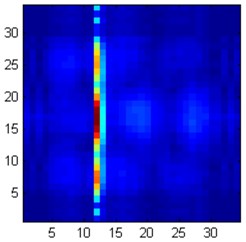
a)
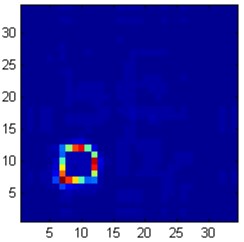
b)
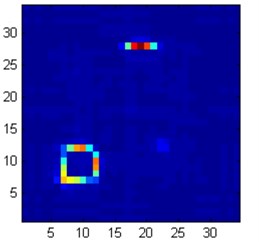
c)
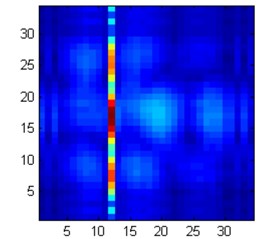
d)
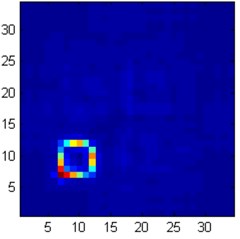
e)
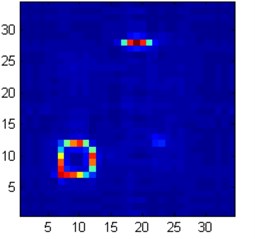
f)
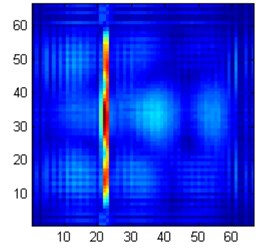
g)
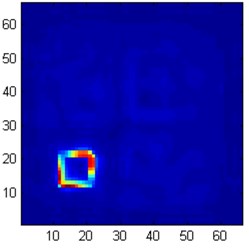
h)
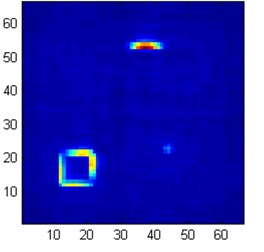
i)
3. Results and comparative studies
In order to verify the proposed approach several tests were carried out both on numerical and experimental data. During the analysis several types of composite structures as well as several types of damages were considered. As examples three cases of pre-damaged laminated plates made of glass/epoxy were selected. The first case consisted a through-the-width crack, the second case consisted the spatial square damage and the third case consisted three damages: two spatial square damages with various dimensions and one short crack. All of the damages have the depth of 20 % (0.5 mm) with respect to the thickness (2.5 mm) of plates. The detailed description of the investigated cases was presented in [10]. First five bending modes of investigated plates were considered during the analysis. The parameters of the fractional B-spline wavelet were selected by trial-and-error method and assumed as follows: order α= 0.8, τ=(α+1)/2 for FrWT- and IUFrWT-based algorithms, for DWT-based algorithm the quadratic B-spline wavelet was selected. The results of damage identification using DWT-based algorithm presented in [11], FrWT-based algorithm presented in [10] and IUFrWT-based algorithm applied for numerical and experimental data were presented in Figs. 1 and 2, respectively.
Fig. 2Results of damage identification using the algorithms based on a)-c) DWT, d)-f) FrWT, g)-i) IUFrWT for experimental data
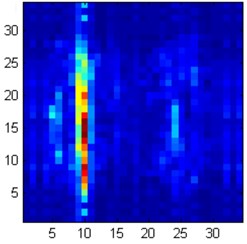
a)
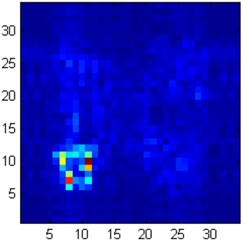
b)
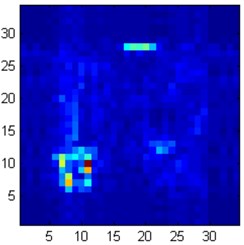
c)
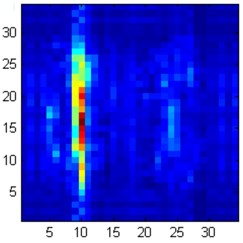
d)
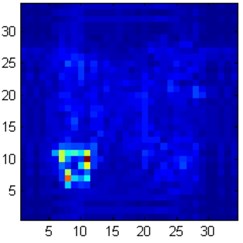
e)
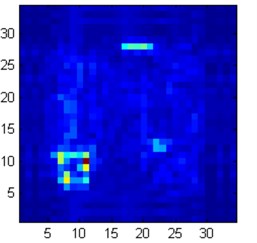
f)
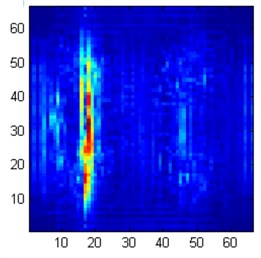
g)

h)
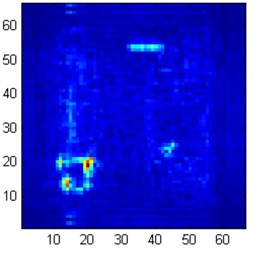
i)
It can be noticed that the damages were properly detected by all of considered algorithms, however the better resolution of IUFrWT-based algorithm provides better localization performance and better identification of damages. In particular, the magnitudes of coefficients for the small damage in the third case of numerical data are almost the same as the background noise and thus hardly detectable for DWT-based (Fig. 1(c)) and FrWT-based (Fig. 1(f)) algorithms, while using the proposed algorithm in this study the detectability of this damage increases (Fig. 1(i)). The better localization is also observed for the large spatial damage in the second and third cases in experimental data (Figs. 2(h) and 2(i)).
4. Conclusions
The presented novel wavelet transform allows enhancing the performance of detectability, localization ability and identification of damages with respect to other considered wavelet transforms. The application of IUFrWT is critically important when the low number of measurement points is considered during the analysis, because the processing algorithm does not reduce the dimensions of sets of resulted coefficients with respect to the original signals. This is due the substitution of classical DWT decomposition procedure inside FrWT algorithm by undecimaded DWT. The proposed approach could improve the inspection procedures of composite structures being maintained in industrial applications.
References
-
Loutridis S., Douka E., Hadjileontiadis L. J., Trochidis A. A two-dimensional wavelet transform for detection of cracks in plates. Engineering Structures, Vol. 27, Issue 9, 2005, p. 1327-1338.
-
Huang Y., Meyer D., Nemat-Nasser S. Damage detection with spatially distributed 2D continuous wavelet transform. Mechanics of Materials, Vol. 41, Issue 10, 2009, p. 1096-1107.
-
Fan W., Qiao P. A 2-D continuous wavelet transform for mode shape data for damage detection of plate structures. International Journal of Solids and Structures, Vol. 46, Issues 25-26, 2009, p. 4379-4395.
-
Sung D. U., Kim C. G., Hong C. S. Monitoring of impact damages in composite laminates using wavelet transform. Composites: Part B – Engineering, Vol. 33, Issue 1, 2002, p. 35-43.
-
Zhong S., Oyadiji S. O. Crack detection in simply supported beams without baseline modal parameters by stationary wavelet transform. Mechanical Systems and Signal Processing, Vol. 21, Issue 4, 2007, p. 1853-1884.
-
Katunin A. Modal-based non-destructive damage assessment in composite structures using wavelet analysis: a review. International Journal of Composite Materials, Vol. 3, Issue 6B, 2013, p. 1-9.
-
Rucka A., Wilde K. Neuro-wavelet damage detection technique in beam, plate and shell structures with experimental validation. Journal of Theoretical and Applied Mechanics, Vol. 48, Issue 3, 2010, p. 579-604.
-
Hein H., Feklistova L. Computationally efficient delamination detection in composite beams using Haar wavelets. Mechanical Systems and Signal Processing, Vol. 25, Issue 6, 2011, p. 2257-2270.
-
Xiang J., Liang M. A two-step approach to multi-damage detection for plate structures. Engineering Fracture Mechanics, Vol. 91, 2012, p. 73-76.
-
Katunin A., Przystałka P. Damage assessment in composite plates using fractional wavelet transform of modal shapes with optimized selection of spatial wavelets. Engineering Applications of Artificial Intelligence, Vol. 30, 2014, p. 73-85.
-
Katunin A. Damage identification in composite plates using two-dimensional B-spline wavelets. Mechanical Systems and Signal Processing, Vol. 25, Issue 8, 2011, p. 3153-3167.
-
Unser M., Blu T. Fractional splines and wavelets. SIAM Reviews, Vol. 42, 2000, p. 43-67.
-
Chaudhury K. N., Unser M. Construction of Hilbert transform pairs of wavelet bases and Gabor-like transforms. IEEE Transactions on Signal Processing, Vol. 57, 2009, p. 3411-3425.
-
Katunin A., Przystałka P. Structural diagnostics of composite beams using optimally selected fractional B-spline wavelets. Intelligent Systems in Technical and Medical Diagnostics, Advances in Intelligent Systems and Computing, Vol. 230, 2014, p. 465-486.
-
Katunin A., Przystałka P. Detection and localization of delaminations in composite beams using fractional B-spline wavelets with optimized parameters. Eksploatacja i Niezawodnosc - Maintenatce and Reliability, Vol. 15, Issue 3, 2014, p. 391-399.
-
Starck J. L., Fadili J., Murtagh F. The undecimated wavelet decomposition and its reconstruction. IEEE Transactions on Image Processing, Vol. 16, Issue 2, 2007, p. 297-309.
About this article
The research project was financed by the National Science Centre (Poland) granted according the decision no. DEC-2011/03/N/ST8/06205.
